An Analysis of Social Enterprise and Community Development's Interplay
VerifiedAdded on 2022/08/25
|14
|4092
|19
Essay
AI Summary
This essay examines the role of social enterprises in community development, highlighting their multifaceted impact on society. It begins by defining community development and social enterprise, emphasizing their shared goals of social justice, equality, and community empowerment. The essay explores how social enterprises address social ills through fundraising, particularly using crowd-funding platforms to support programs for the homeless and other vulnerable populations. It emphasizes the importance of community principles, such as democratic social welfare, cooperation, and citizen partnership, for effective engagement. The essay discusses the roles of project managers and café managers in facilitating community development, providing skills, confidence, and opportunities for social interaction. Finally, it underscores the significance of social enterprises' online presence and their ability to disseminate information and mobilize support for social causes. The essay concludes by highlighting the crucial role these organizations play in improving community life and addressing various social issues.
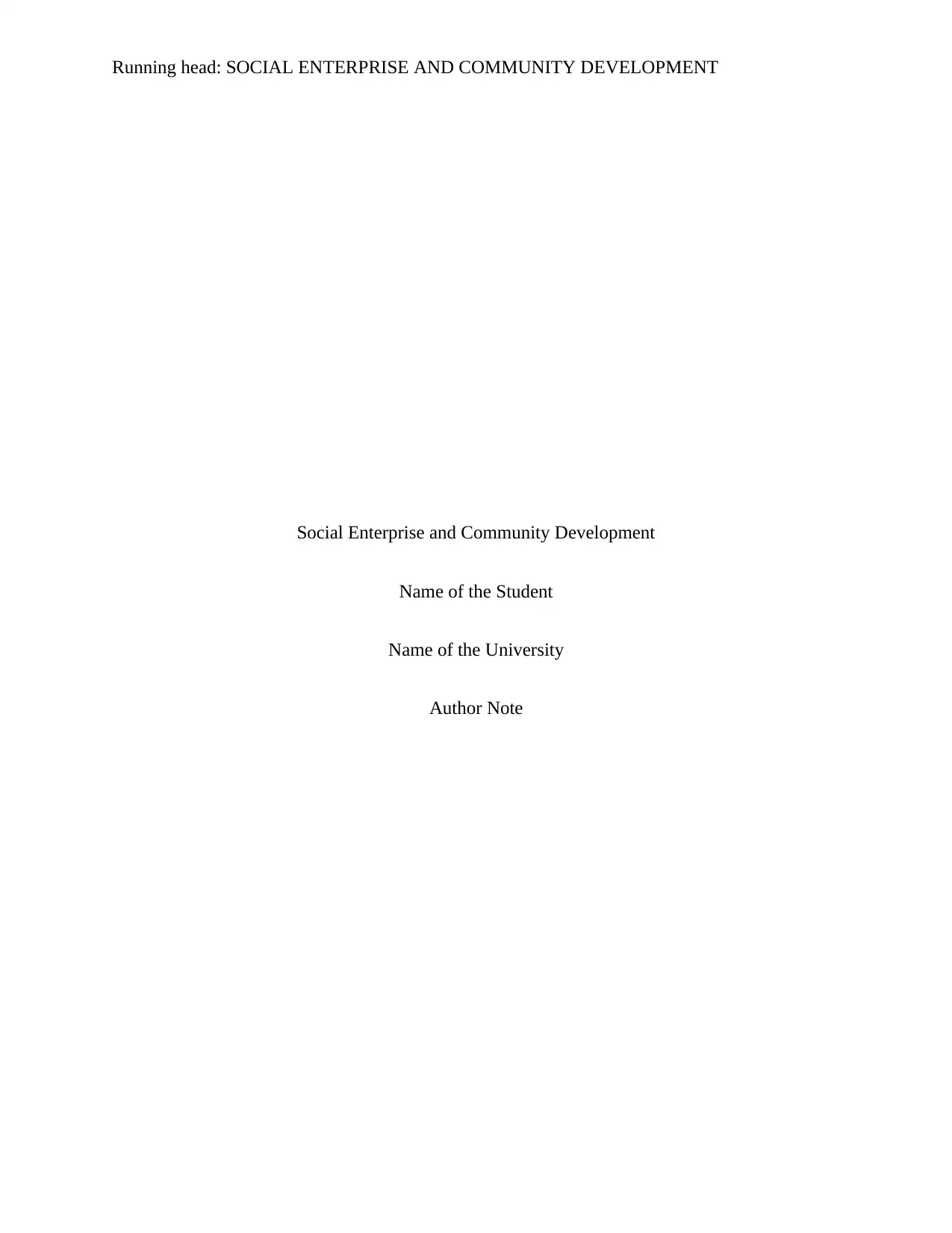
Running head: SOCIAL ENTERPRISE AND COMMUNITY DEVELOPMENT
Social Enterprise and Community Development
Name of the Student
Name of the University
Author Note
Social Enterprise and Community Development
Name of the Student
Name of the University
Author Note
Paraphrase This Document
Need a fresh take? Get an instant paraphrase of this document with our AI Paraphraser
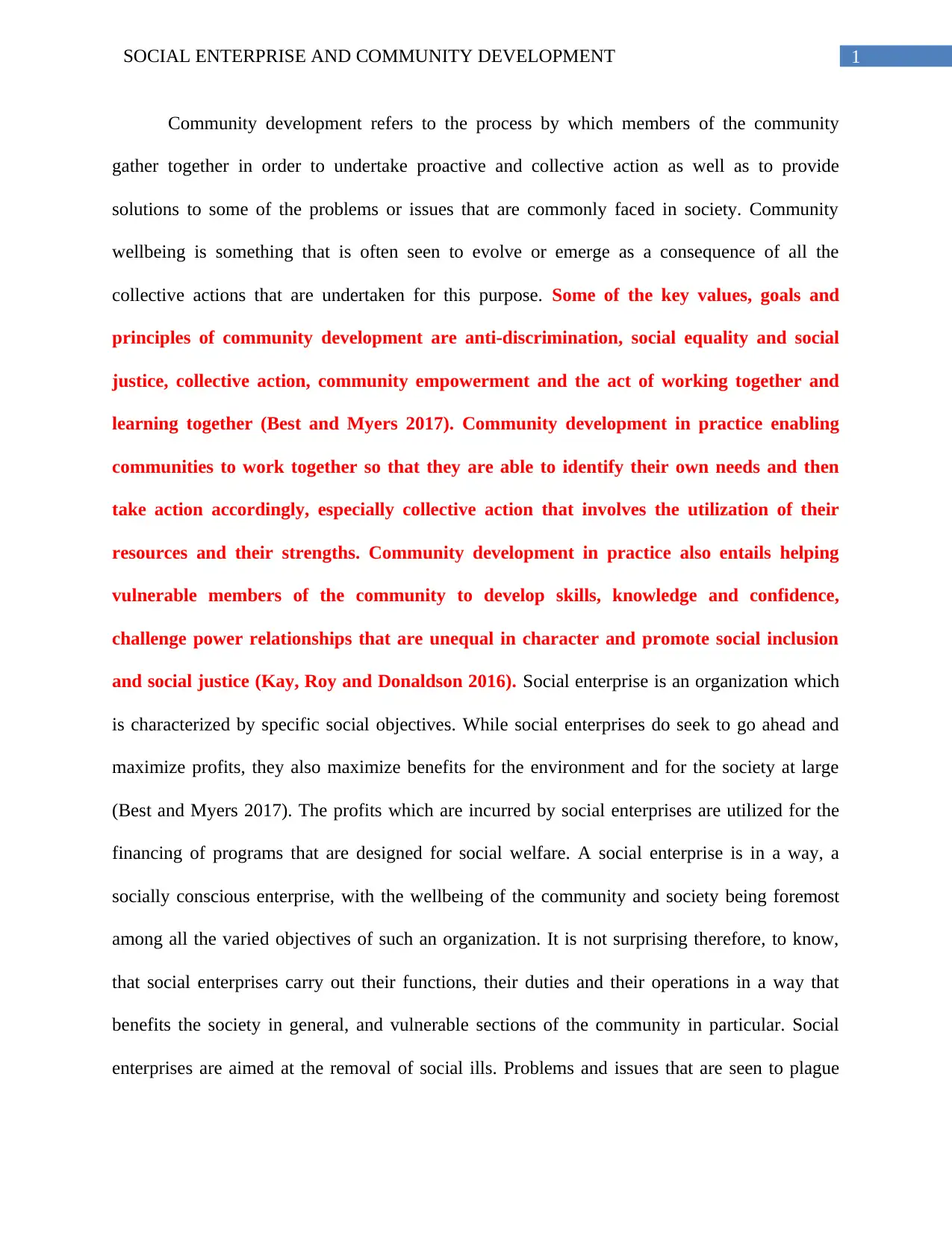
1SOCIAL ENTERPRISE AND COMMUNITY DEVELOPMENT
Community development refers to the process by which members of the community
gather together in order to undertake proactive and collective action as well as to provide
solutions to some of the problems or issues that are commonly faced in society. Community
wellbeing is something that is often seen to evolve or emerge as a consequence of all the
collective actions that are undertaken for this purpose. Some of the key values, goals and
principles of community development are anti-discrimination, social equality and social
justice, collective action, community empowerment and the act of working together and
learning together (Best and Myers 2017). Community development in practice enabling
communities to work together so that they are able to identify their own needs and then
take action accordingly, especially collective action that involves the utilization of their
resources and their strengths. Community development in practice also entails helping
vulnerable members of the community to develop skills, knowledge and confidence,
challenge power relationships that are unequal in character and promote social inclusion
and social justice (Kay, Roy and Donaldson 2016). Social enterprise is an organization which
is characterized by specific social objectives. While social enterprises do seek to go ahead and
maximize profits, they also maximize benefits for the environment and for the society at large
(Best and Myers 2017). The profits which are incurred by social enterprises are utilized for the
financing of programs that are designed for social welfare. A social enterprise is in a way, a
socially conscious enterprise, with the wellbeing of the community and society being foremost
among all the varied objectives of such an organization. It is not surprising therefore, to know,
that social enterprises carry out their functions, their duties and their operations in a way that
benefits the society in general, and vulnerable sections of the community in particular. Social
enterprises are aimed at the removal of social ills. Problems and issues that are seen to plague
Community development refers to the process by which members of the community
gather together in order to undertake proactive and collective action as well as to provide
solutions to some of the problems or issues that are commonly faced in society. Community
wellbeing is something that is often seen to evolve or emerge as a consequence of all the
collective actions that are undertaken for this purpose. Some of the key values, goals and
principles of community development are anti-discrimination, social equality and social
justice, collective action, community empowerment and the act of working together and
learning together (Best and Myers 2017). Community development in practice enabling
communities to work together so that they are able to identify their own needs and then
take action accordingly, especially collective action that involves the utilization of their
resources and their strengths. Community development in practice also entails helping
vulnerable members of the community to develop skills, knowledge and confidence,
challenge power relationships that are unequal in character and promote social inclusion
and social justice (Kay, Roy and Donaldson 2016). Social enterprise is an organization which
is characterized by specific social objectives. While social enterprises do seek to go ahead and
maximize profits, they also maximize benefits for the environment and for the society at large
(Best and Myers 2017). The profits which are incurred by social enterprises are utilized for the
financing of programs that are designed for social welfare. A social enterprise is in a way, a
socially conscious enterprise, with the wellbeing of the community and society being foremost
among all the varied objectives of such an organization. It is not surprising therefore, to know,
that social enterprises carry out their functions, their duties and their operations in a way that
benefits the society in general, and vulnerable sections of the community in particular. Social
enterprises are aimed at the removal of social ills. Problems and issues that are seen to plague
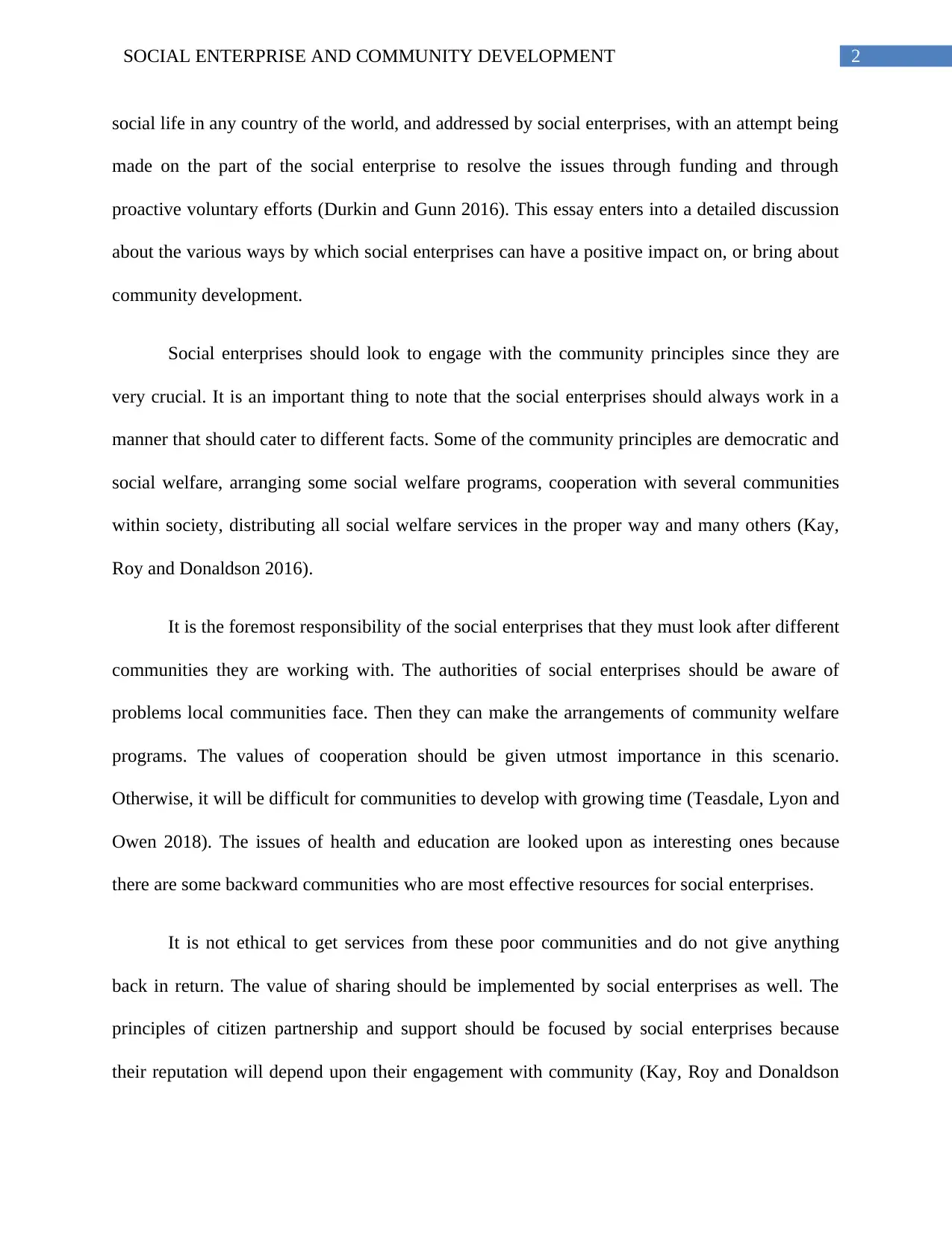
2SOCIAL ENTERPRISE AND COMMUNITY DEVELOPMENT
social life in any country of the world, and addressed by social enterprises, with an attempt being
made on the part of the social enterprise to resolve the issues through funding and through
proactive voluntary efforts (Durkin and Gunn 2016). This essay enters into a detailed discussion
about the various ways by which social enterprises can have a positive impact on, or bring about
community development.
Social enterprises should look to engage with the community principles since they are
very crucial. It is an important thing to note that the social enterprises should always work in a
manner that should cater to different facts. Some of the community principles are democratic and
social welfare, arranging some social welfare programs, cooperation with several communities
within society, distributing all social welfare services in the proper way and many others (Kay,
Roy and Donaldson 2016).
It is the foremost responsibility of the social enterprises that they must look after different
communities they are working with. The authorities of social enterprises should be aware of
problems local communities face. Then they can make the arrangements of community welfare
programs. The values of cooperation should be given utmost importance in this scenario.
Otherwise, it will be difficult for communities to develop with growing time (Teasdale, Lyon and
Owen 2018). The issues of health and education are looked upon as interesting ones because
there are some backward communities who are most effective resources for social enterprises.
It is not ethical to get services from these poor communities and do not give anything
back in return. The value of sharing should be implemented by social enterprises as well. The
principles of citizen partnership and support should be focused by social enterprises because
their reputation will depend upon their engagement with community (Kay, Roy and Donaldson
social life in any country of the world, and addressed by social enterprises, with an attempt being
made on the part of the social enterprise to resolve the issues through funding and through
proactive voluntary efforts (Durkin and Gunn 2016). This essay enters into a detailed discussion
about the various ways by which social enterprises can have a positive impact on, or bring about
community development.
Social enterprises should look to engage with the community principles since they are
very crucial. It is an important thing to note that the social enterprises should always work in a
manner that should cater to different facts. Some of the community principles are democratic and
social welfare, arranging some social welfare programs, cooperation with several communities
within society, distributing all social welfare services in the proper way and many others (Kay,
Roy and Donaldson 2016).
It is the foremost responsibility of the social enterprises that they must look after different
communities they are working with. The authorities of social enterprises should be aware of
problems local communities face. Then they can make the arrangements of community welfare
programs. The values of cooperation should be given utmost importance in this scenario.
Otherwise, it will be difficult for communities to develop with growing time (Teasdale, Lyon and
Owen 2018). The issues of health and education are looked upon as interesting ones because
there are some backward communities who are most effective resources for social enterprises.
It is not ethical to get services from these poor communities and do not give anything
back in return. The value of sharing should be implemented by social enterprises as well. The
principles of citizen partnership and support should be focused by social enterprises because
their reputation will depend upon their engagement with community (Kay, Roy and Donaldson
⊘ This is a preview!⊘
Do you want full access?
Subscribe today to unlock all pages.

Trusted by 1+ million students worldwide
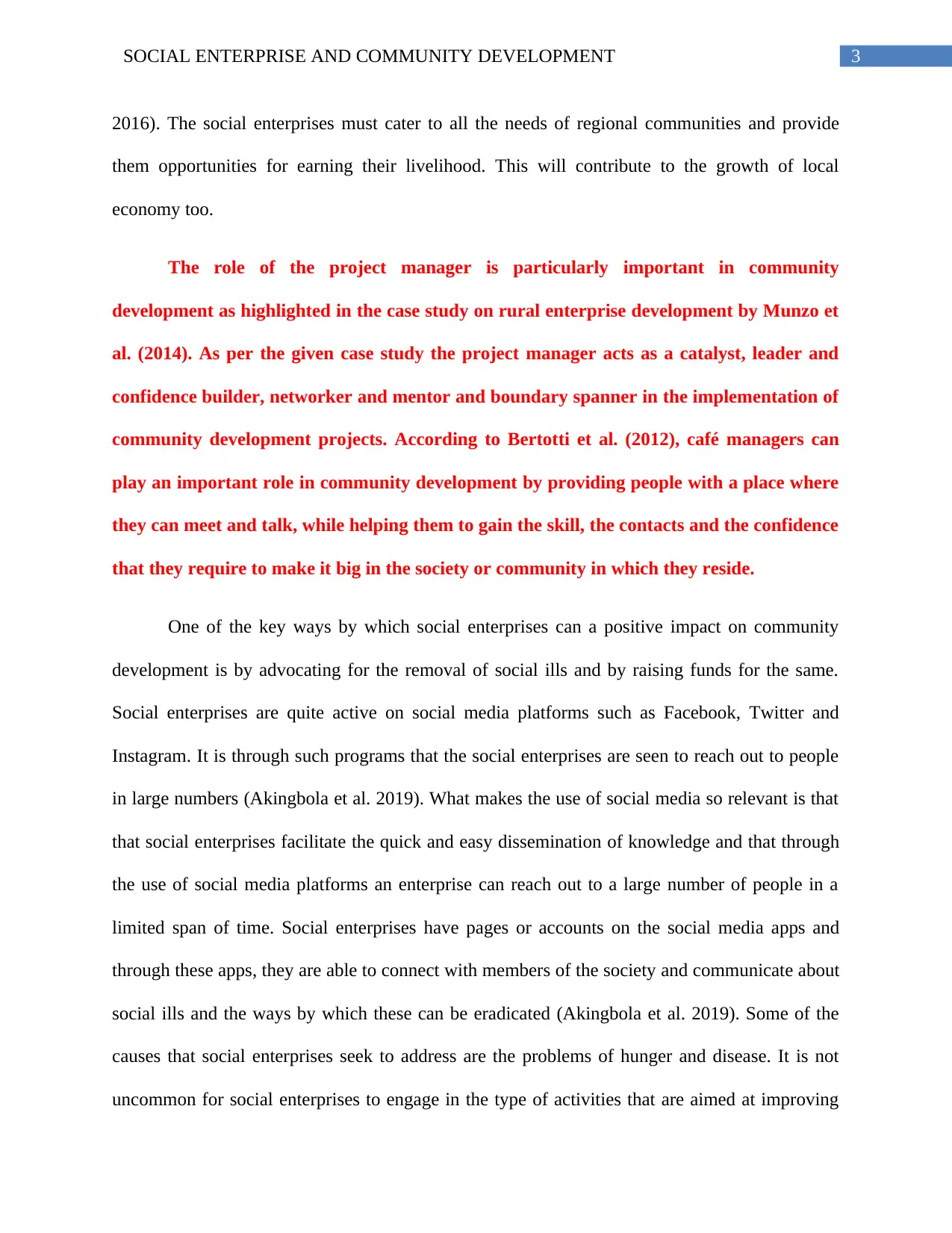
3SOCIAL ENTERPRISE AND COMMUNITY DEVELOPMENT
2016). The social enterprises must cater to all the needs of regional communities and provide
them opportunities for earning their livelihood. This will contribute to the growth of local
economy too.
The role of the project manager is particularly important in community
development as highlighted in the case study on rural enterprise development by Munzo et
al. (2014). As per the given case study the project manager acts as a catalyst, leader and
confidence builder, networker and mentor and boundary spanner in the implementation of
community development projects. According to Bertotti et al. (2012), café managers can
play an important role in community development by providing people with a place where
they can meet and talk, while helping them to gain the skill, the contacts and the confidence
that they require to make it big in the society or community in which they reside.
One of the key ways by which social enterprises can a positive impact on community
development is by advocating for the removal of social ills and by raising funds for the same.
Social enterprises are quite active on social media platforms such as Facebook, Twitter and
Instagram. It is through such programs that the social enterprises are seen to reach out to people
in large numbers (Akingbola et al. 2019). What makes the use of social media so relevant is that
that social enterprises facilitate the quick and easy dissemination of knowledge and that through
the use of social media platforms an enterprise can reach out to a large number of people in a
limited span of time. Social enterprises have pages or accounts on the social media apps and
through these apps, they are able to connect with members of the society and communicate about
social ills and the ways by which these can be eradicated (Akingbola et al. 2019). Some of the
causes that social enterprises seek to address are the problems of hunger and disease. It is not
uncommon for social enterprises to engage in the type of activities that are aimed at improving
2016). The social enterprises must cater to all the needs of regional communities and provide
them opportunities for earning their livelihood. This will contribute to the growth of local
economy too.
The role of the project manager is particularly important in community
development as highlighted in the case study on rural enterprise development by Munzo et
al. (2014). As per the given case study the project manager acts as a catalyst, leader and
confidence builder, networker and mentor and boundary spanner in the implementation of
community development projects. According to Bertotti et al. (2012), café managers can
play an important role in community development by providing people with a place where
they can meet and talk, while helping them to gain the skill, the contacts and the confidence
that they require to make it big in the society or community in which they reside.
One of the key ways by which social enterprises can a positive impact on community
development is by advocating for the removal of social ills and by raising funds for the same.
Social enterprises are quite active on social media platforms such as Facebook, Twitter and
Instagram. It is through such programs that the social enterprises are seen to reach out to people
in large numbers (Akingbola et al. 2019). What makes the use of social media so relevant is that
that social enterprises facilitate the quick and easy dissemination of knowledge and that through
the use of social media platforms an enterprise can reach out to a large number of people in a
limited span of time. Social enterprises have pages or accounts on the social media apps and
through these apps, they are able to connect with members of the society and communicate about
social ills and the ways by which these can be eradicated (Akingbola et al. 2019). Some of the
causes that social enterprises seek to address are the problems of hunger and disease. It is not
uncommon for social enterprises to engage in the type of activities that are aimed at improving
Paraphrase This Document
Need a fresh take? Get an instant paraphrase of this document with our AI Paraphraser

4SOCIAL ENTERPRISE AND COMMUNITY DEVELOPMENT
the lot of the homeless people living in a country. Social enterprises more often than not, are
seen to partake in fund raising activities in order to procure the money that is necessary for
funding social welfare programs such as programs that will help to feed the homeless
populations of a country well enough and which will keep them from feeling as starved as they
would otherwise be in the absence of regular food. Social enterprises are particularly seen to use
the process of crowd funding in order to raise money as well as support for community related
programs for the homeless (Teasdale et al. 2018).
Crowd funding makes use of a common platform for the purpose of fund raising. Social
enterprises usually advertise the reason why funds are being raised, the specific cause that the
funds are going to be used for and the ways and means by which people can contribute the funds
and the time limit in which they can do the same. Crowd funding constitutes one of the most
effective ways by which to raise money for a social cause and social enterprises are seen to make
active use of crowd funding in order to come up with the money that is needed for the funding of
community development programs such as arranging for regular food and shelter for the
homeless (Peredo and Chrissman 2017). In addition to crowd funding, the social enterprises are
also seen to contribute their own capital towards a social cause, so as to enable the cause to be
addressed in the manner that is desired. The profits which are incurred by the social enterprise
through the running of business operations are kept aside for funding community development
activities. Efforts are made by social enterprises to make sure of the fact that homeless people are
not left out on the streets and that they have a place to go to for food and comfort, and this is
done not just through the crowd funding programs but also through the contribution of capital as
earned by social enterprises through their various business operations (Peredo and Chrissman
2017).
the lot of the homeless people living in a country. Social enterprises more often than not, are
seen to partake in fund raising activities in order to procure the money that is necessary for
funding social welfare programs such as programs that will help to feed the homeless
populations of a country well enough and which will keep them from feeling as starved as they
would otherwise be in the absence of regular food. Social enterprises are particularly seen to use
the process of crowd funding in order to raise money as well as support for community related
programs for the homeless (Teasdale et al. 2018).
Crowd funding makes use of a common platform for the purpose of fund raising. Social
enterprises usually advertise the reason why funds are being raised, the specific cause that the
funds are going to be used for and the ways and means by which people can contribute the funds
and the time limit in which they can do the same. Crowd funding constitutes one of the most
effective ways by which to raise money for a social cause and social enterprises are seen to make
active use of crowd funding in order to come up with the money that is needed for the funding of
community development programs such as arranging for regular food and shelter for the
homeless (Peredo and Chrissman 2017). In addition to crowd funding, the social enterprises are
also seen to contribute their own capital towards a social cause, so as to enable the cause to be
addressed in the manner that is desired. The profits which are incurred by the social enterprise
through the running of business operations are kept aside for funding community development
activities. Efforts are made by social enterprises to make sure of the fact that homeless people are
not left out on the streets and that they have a place to go to for food and comfort, and this is
done not just through the crowd funding programs but also through the contribution of capital as
earned by social enterprises through their various business operations (Peredo and Chrissman
2017).
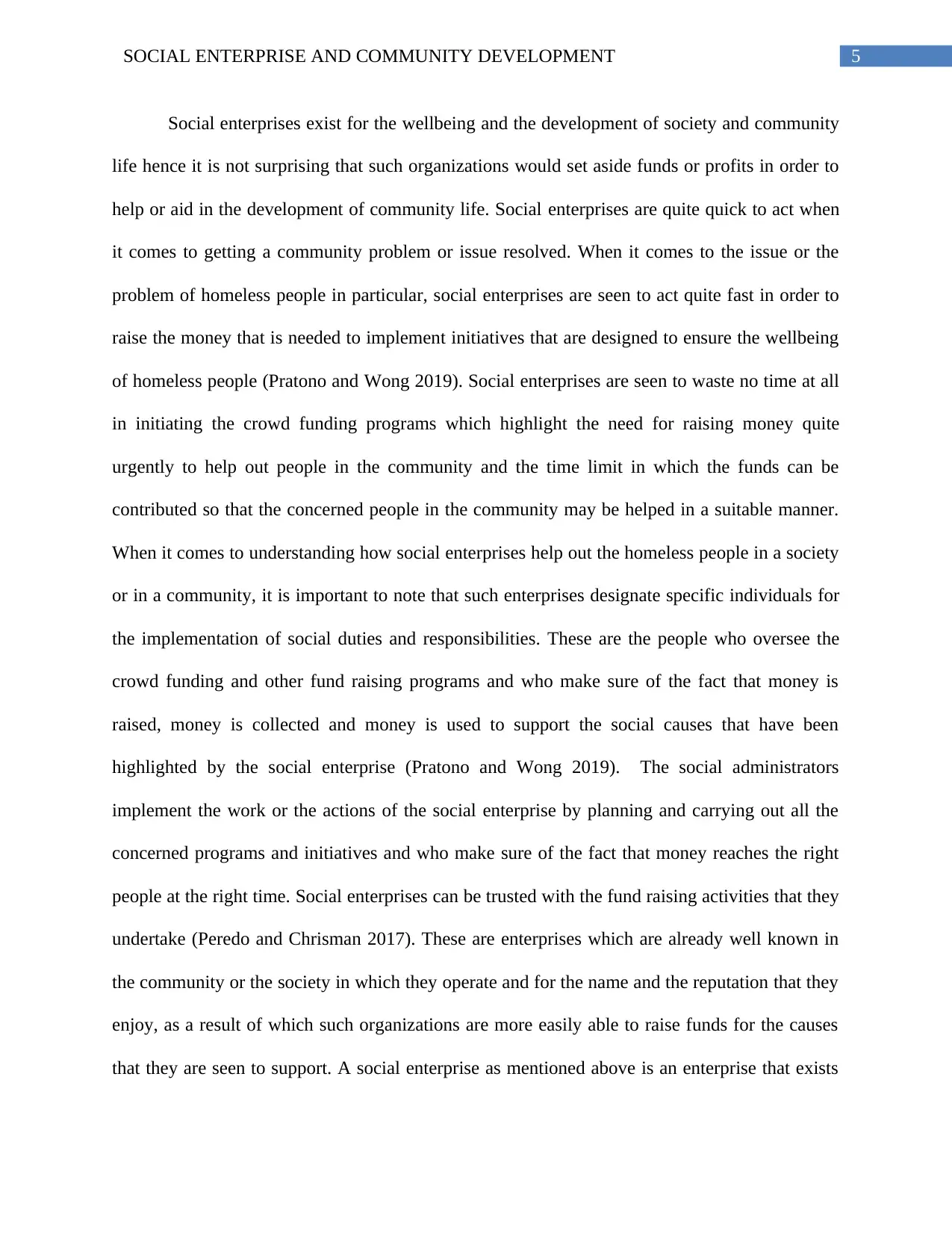
5SOCIAL ENTERPRISE AND COMMUNITY DEVELOPMENT
Social enterprises exist for the wellbeing and the development of society and community
life hence it is not surprising that such organizations would set aside funds or profits in order to
help or aid in the development of community life. Social enterprises are quite quick to act when
it comes to getting a community problem or issue resolved. When it comes to the issue or the
problem of homeless people in particular, social enterprises are seen to act quite fast in order to
raise the money that is needed to implement initiatives that are designed to ensure the wellbeing
of homeless people (Pratono and Wong 2019). Social enterprises are seen to waste no time at all
in initiating the crowd funding programs which highlight the need for raising money quite
urgently to help out people in the community and the time limit in which the funds can be
contributed so that the concerned people in the community may be helped in a suitable manner.
When it comes to understanding how social enterprises help out the homeless people in a society
or in a community, it is important to note that such enterprises designate specific individuals for
the implementation of social duties and responsibilities. These are the people who oversee the
crowd funding and other fund raising programs and who make sure of the fact that money is
raised, money is collected and money is used to support the social causes that have been
highlighted by the social enterprise (Pratono and Wong 2019). The social administrators
implement the work or the actions of the social enterprise by planning and carrying out all the
concerned programs and initiatives and who make sure of the fact that money reaches the right
people at the right time. Social enterprises can be trusted with the fund raising activities that they
undertake (Peredo and Chrisman 2017). These are enterprises which are already well known in
the community or the society in which they operate and for the name and the reputation that they
enjoy, as a result of which such organizations are more easily able to raise funds for the causes
that they are seen to support. A social enterprise as mentioned above is an enterprise that exists
Social enterprises exist for the wellbeing and the development of society and community
life hence it is not surprising that such organizations would set aside funds or profits in order to
help or aid in the development of community life. Social enterprises are quite quick to act when
it comes to getting a community problem or issue resolved. When it comes to the issue or the
problem of homeless people in particular, social enterprises are seen to act quite fast in order to
raise the money that is needed to implement initiatives that are designed to ensure the wellbeing
of homeless people (Pratono and Wong 2019). Social enterprises are seen to waste no time at all
in initiating the crowd funding programs which highlight the need for raising money quite
urgently to help out people in the community and the time limit in which the funds can be
contributed so that the concerned people in the community may be helped in a suitable manner.
When it comes to understanding how social enterprises help out the homeless people in a society
or in a community, it is important to note that such enterprises designate specific individuals for
the implementation of social duties and responsibilities. These are the people who oversee the
crowd funding and other fund raising programs and who make sure of the fact that money is
raised, money is collected and money is used to support the social causes that have been
highlighted by the social enterprise (Pratono and Wong 2019). The social administrators
implement the work or the actions of the social enterprise by planning and carrying out all the
concerned programs and initiatives and who make sure of the fact that money reaches the right
people at the right time. Social enterprises can be trusted with the fund raising activities that they
undertake (Peredo and Chrisman 2017). These are enterprises which are already well known in
the community or the society in which they operate and for the name and the reputation that they
enjoy, as a result of which such organizations are more easily able to raise funds for the causes
that they are seen to support. A social enterprise as mentioned above is an enterprise that exists
⊘ This is a preview!⊘
Do you want full access?
Subscribe today to unlock all pages.

Trusted by 1+ million students worldwide
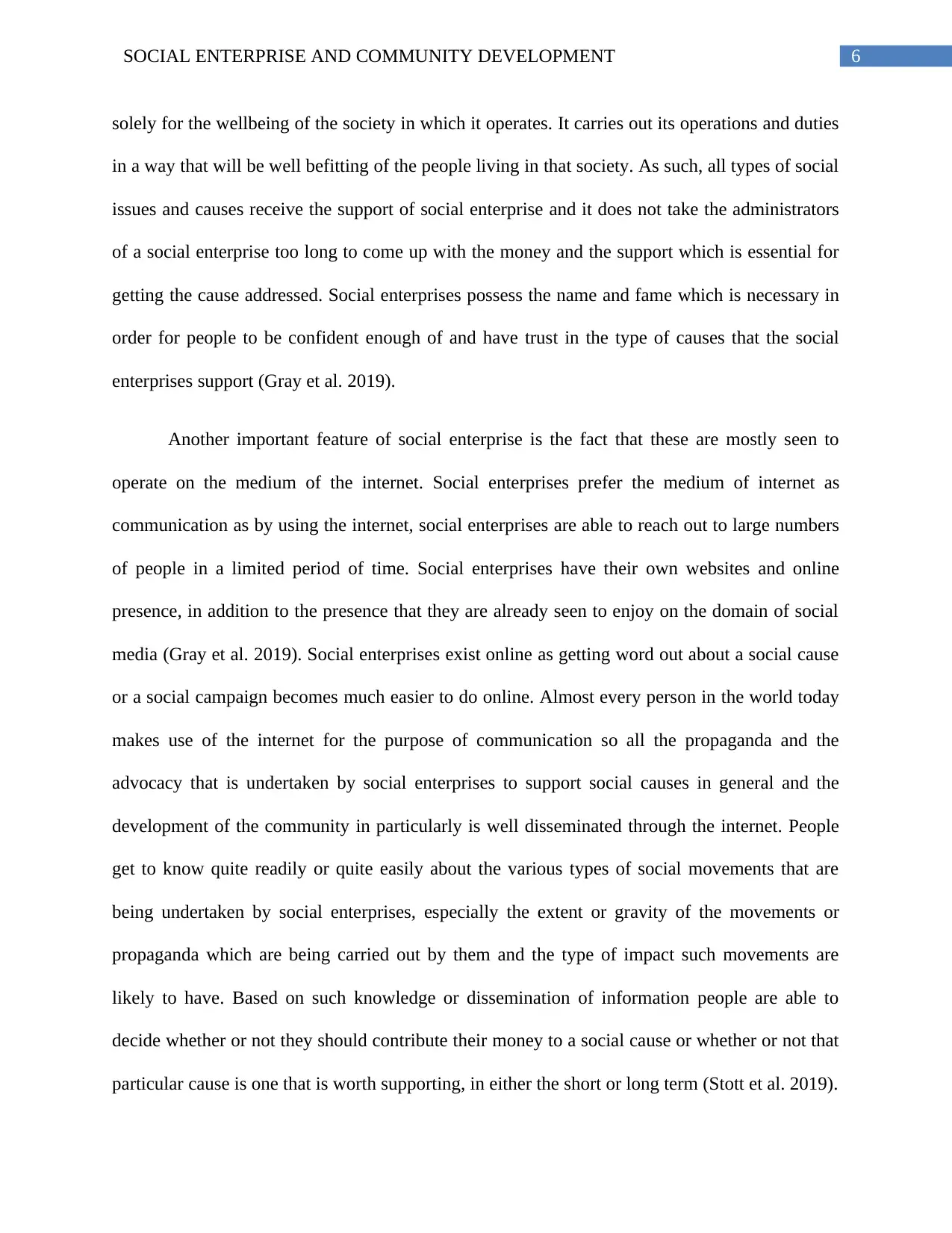
6SOCIAL ENTERPRISE AND COMMUNITY DEVELOPMENT
solely for the wellbeing of the society in which it operates. It carries out its operations and duties
in a way that will be well befitting of the people living in that society. As such, all types of social
issues and causes receive the support of social enterprise and it does not take the administrators
of a social enterprise too long to come up with the money and the support which is essential for
getting the cause addressed. Social enterprises possess the name and fame which is necessary in
order for people to be confident enough of and have trust in the type of causes that the social
enterprises support (Gray et al. 2019).
Another important feature of social enterprise is the fact that these are mostly seen to
operate on the medium of the internet. Social enterprises prefer the medium of internet as
communication as by using the internet, social enterprises are able to reach out to large numbers
of people in a limited period of time. Social enterprises have their own websites and online
presence, in addition to the presence that they are already seen to enjoy on the domain of social
media (Gray et al. 2019). Social enterprises exist online as getting word out about a social cause
or a social campaign becomes much easier to do online. Almost every person in the world today
makes use of the internet for the purpose of communication so all the propaganda and the
advocacy that is undertaken by social enterprises to support social causes in general and the
development of the community in particularly is well disseminated through the internet. People
get to know quite readily or quite easily about the various types of social movements that are
being undertaken by social enterprises, especially the extent or gravity of the movements or
propaganda which are being carried out by them and the type of impact such movements are
likely to have. Based on such knowledge or dissemination of information people are able to
decide whether or not they should contribute their money to a social cause or whether or not that
particular cause is one that is worth supporting, in either the short or long term (Stott et al. 2019).
solely for the wellbeing of the society in which it operates. It carries out its operations and duties
in a way that will be well befitting of the people living in that society. As such, all types of social
issues and causes receive the support of social enterprise and it does not take the administrators
of a social enterprise too long to come up with the money and the support which is essential for
getting the cause addressed. Social enterprises possess the name and fame which is necessary in
order for people to be confident enough of and have trust in the type of causes that the social
enterprises support (Gray et al. 2019).
Another important feature of social enterprise is the fact that these are mostly seen to
operate on the medium of the internet. Social enterprises prefer the medium of internet as
communication as by using the internet, social enterprises are able to reach out to large numbers
of people in a limited period of time. Social enterprises have their own websites and online
presence, in addition to the presence that they are already seen to enjoy on the domain of social
media (Gray et al. 2019). Social enterprises exist online as getting word out about a social cause
or a social campaign becomes much easier to do online. Almost every person in the world today
makes use of the internet for the purpose of communication so all the propaganda and the
advocacy that is undertaken by social enterprises to support social causes in general and the
development of the community in particularly is well disseminated through the internet. People
get to know quite readily or quite easily about the various types of social movements that are
being undertaken by social enterprises, especially the extent or gravity of the movements or
propaganda which are being carried out by them and the type of impact such movements are
likely to have. Based on such knowledge or dissemination of information people are able to
decide whether or not they should contribute their money to a social cause or whether or not that
particular cause is one that is worth supporting, in either the short or long term (Stott et al. 2019).
Paraphrase This Document
Need a fresh take? Get an instant paraphrase of this document with our AI Paraphraser
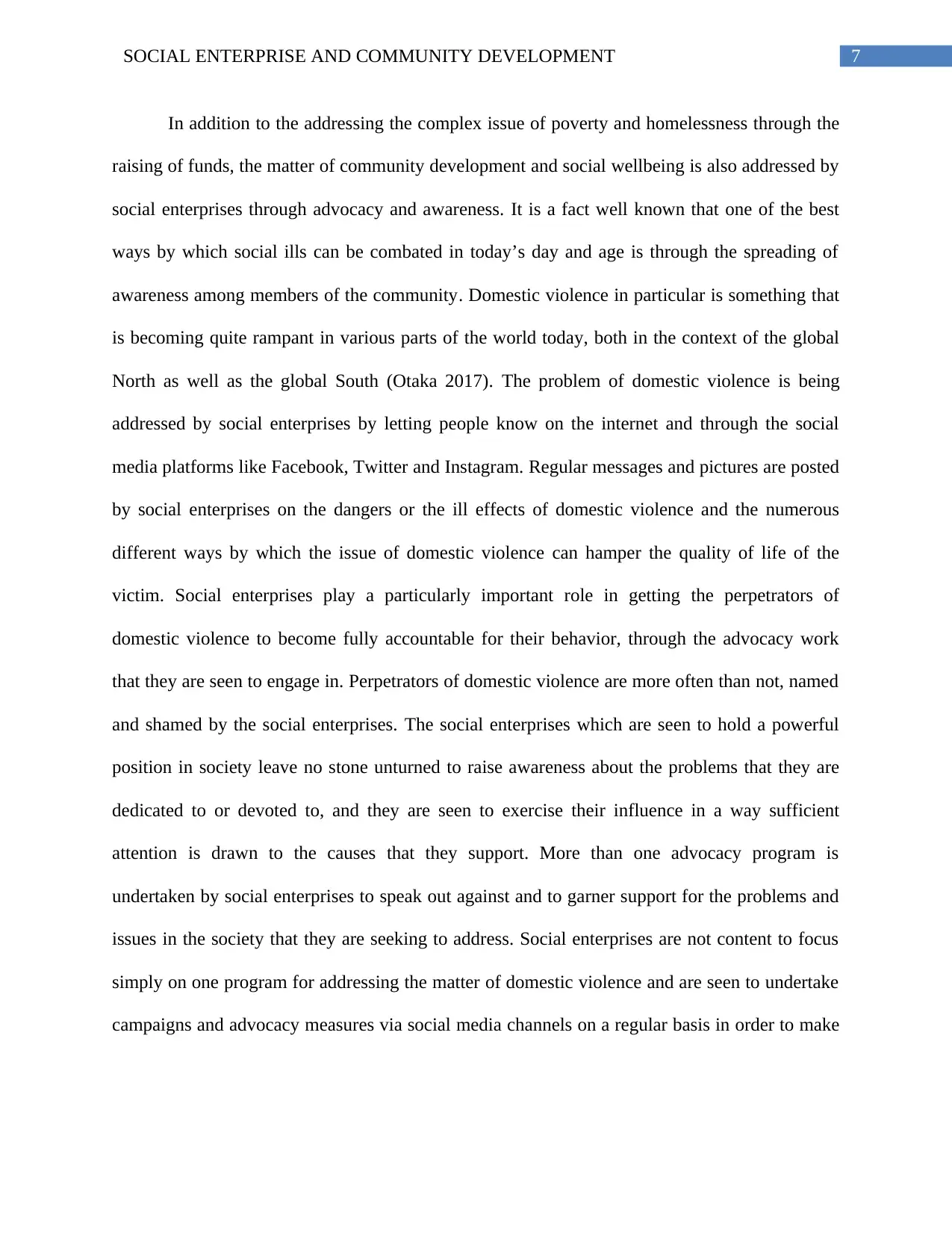
7SOCIAL ENTERPRISE AND COMMUNITY DEVELOPMENT
In addition to the addressing the complex issue of poverty and homelessness through the
raising of funds, the matter of community development and social wellbeing is also addressed by
social enterprises through advocacy and awareness. It is a fact well known that one of the best
ways by which social ills can be combated in today’s day and age is through the spreading of
awareness among members of the community. Domestic violence in particular is something that
is becoming quite rampant in various parts of the world today, both in the context of the global
North as well as the global South (Otaka 2017). The problem of domestic violence is being
addressed by social enterprises by letting people know on the internet and through the social
media platforms like Facebook, Twitter and Instagram. Regular messages and pictures are posted
by social enterprises on the dangers or the ill effects of domestic violence and the numerous
different ways by which the issue of domestic violence can hamper the quality of life of the
victim. Social enterprises play a particularly important role in getting the perpetrators of
domestic violence to become fully accountable for their behavior, through the advocacy work
that they are seen to engage in. Perpetrators of domestic violence are more often than not, named
and shamed by the social enterprises. The social enterprises which are seen to hold a powerful
position in society leave no stone unturned to raise awareness about the problems that they are
dedicated to or devoted to, and they are seen to exercise their influence in a way sufficient
attention is drawn to the causes that they support. More than one advocacy program is
undertaken by social enterprises to speak out against and to garner support for the problems and
issues in the society that they are seeking to address. Social enterprises are not content to focus
simply on one program for addressing the matter of domestic violence and are seen to undertake
campaigns and advocacy measures via social media channels on a regular basis in order to make
In addition to the addressing the complex issue of poverty and homelessness through the
raising of funds, the matter of community development and social wellbeing is also addressed by
social enterprises through advocacy and awareness. It is a fact well known that one of the best
ways by which social ills can be combated in today’s day and age is through the spreading of
awareness among members of the community. Domestic violence in particular is something that
is becoming quite rampant in various parts of the world today, both in the context of the global
North as well as the global South (Otaka 2017). The problem of domestic violence is being
addressed by social enterprises by letting people know on the internet and through the social
media platforms like Facebook, Twitter and Instagram. Regular messages and pictures are posted
by social enterprises on the dangers or the ill effects of domestic violence and the numerous
different ways by which the issue of domestic violence can hamper the quality of life of the
victim. Social enterprises play a particularly important role in getting the perpetrators of
domestic violence to become fully accountable for their behavior, through the advocacy work
that they are seen to engage in. Perpetrators of domestic violence are more often than not, named
and shamed by the social enterprises. The social enterprises which are seen to hold a powerful
position in society leave no stone unturned to raise awareness about the problems that they are
dedicated to or devoted to, and they are seen to exercise their influence in a way sufficient
attention is drawn to the causes that they support. More than one advocacy program is
undertaken by social enterprises to speak out against and to garner support for the problems and
issues in the society that they are seeking to address. Social enterprises are not content to focus
simply on one program for addressing the matter of domestic violence and are seen to undertake
campaigns and advocacy measures via social media channels on a regular basis in order to make
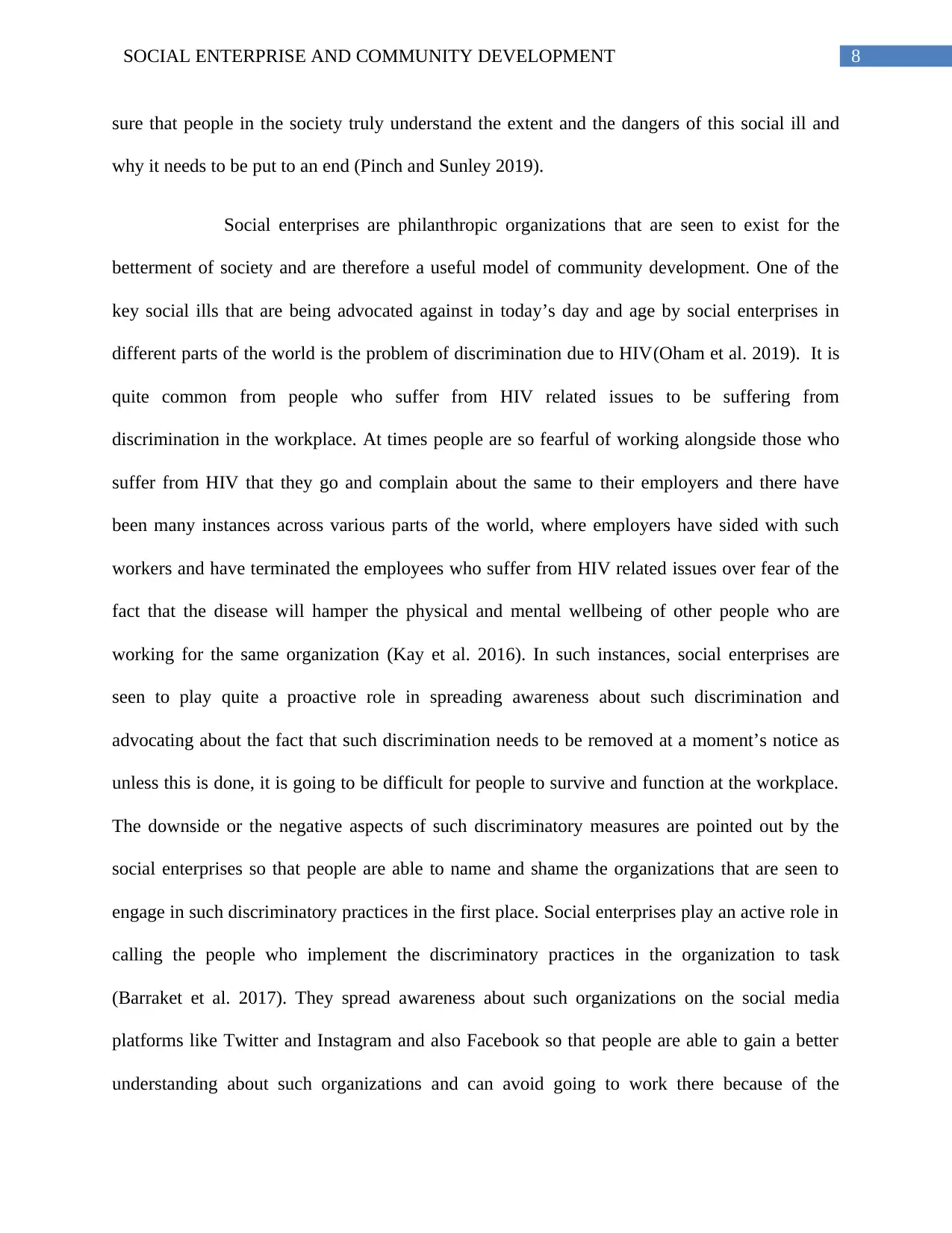
8SOCIAL ENTERPRISE AND COMMUNITY DEVELOPMENT
sure that people in the society truly understand the extent and the dangers of this social ill and
why it needs to be put to an end (Pinch and Sunley 2019).
Social enterprises are philanthropic organizations that are seen to exist for the
betterment of society and are therefore a useful model of community development. One of the
key social ills that are being advocated against in today’s day and age by social enterprises in
different parts of the world is the problem of discrimination due to HIV(Oham et al. 2019). It is
quite common from people who suffer from HIV related issues to be suffering from
discrimination in the workplace. At times people are so fearful of working alongside those who
suffer from HIV that they go and complain about the same to their employers and there have
been many instances across various parts of the world, where employers have sided with such
workers and have terminated the employees who suffer from HIV related issues over fear of the
fact that the disease will hamper the physical and mental wellbeing of other people who are
working for the same organization (Kay et al. 2016). In such instances, social enterprises are
seen to play quite a proactive role in spreading awareness about such discrimination and
advocating about the fact that such discrimination needs to be removed at a moment’s notice as
unless this is done, it is going to be difficult for people to survive and function at the workplace.
The downside or the negative aspects of such discriminatory measures are pointed out by the
social enterprises so that people are able to name and shame the organizations that are seen to
engage in such discriminatory practices in the first place. Social enterprises play an active role in
calling the people who implement the discriminatory practices in the organization to task
(Barraket et al. 2017). They spread awareness about such organizations on the social media
platforms like Twitter and Instagram and also Facebook so that people are able to gain a better
understanding about such organizations and can avoid going to work there because of the
sure that people in the society truly understand the extent and the dangers of this social ill and
why it needs to be put to an end (Pinch and Sunley 2019).
Social enterprises are philanthropic organizations that are seen to exist for the
betterment of society and are therefore a useful model of community development. One of the
key social ills that are being advocated against in today’s day and age by social enterprises in
different parts of the world is the problem of discrimination due to HIV(Oham et al. 2019). It is
quite common from people who suffer from HIV related issues to be suffering from
discrimination in the workplace. At times people are so fearful of working alongside those who
suffer from HIV that they go and complain about the same to their employers and there have
been many instances across various parts of the world, where employers have sided with such
workers and have terminated the employees who suffer from HIV related issues over fear of the
fact that the disease will hamper the physical and mental wellbeing of other people who are
working for the same organization (Kay et al. 2016). In such instances, social enterprises are
seen to play quite a proactive role in spreading awareness about such discrimination and
advocating about the fact that such discrimination needs to be removed at a moment’s notice as
unless this is done, it is going to be difficult for people to survive and function at the workplace.
The downside or the negative aspects of such discriminatory measures are pointed out by the
social enterprises so that people are able to name and shame the organizations that are seen to
engage in such discriminatory practices in the first place. Social enterprises play an active role in
calling the people who implement the discriminatory practices in the organization to task
(Barraket et al. 2017). They spread awareness about such organizations on the social media
platforms like Twitter and Instagram and also Facebook so that people are able to gain a better
understanding about such organizations and can avoid going to work there because of the
⊘ This is a preview!⊘
Do you want full access?
Subscribe today to unlock all pages.

Trusted by 1+ million students worldwide
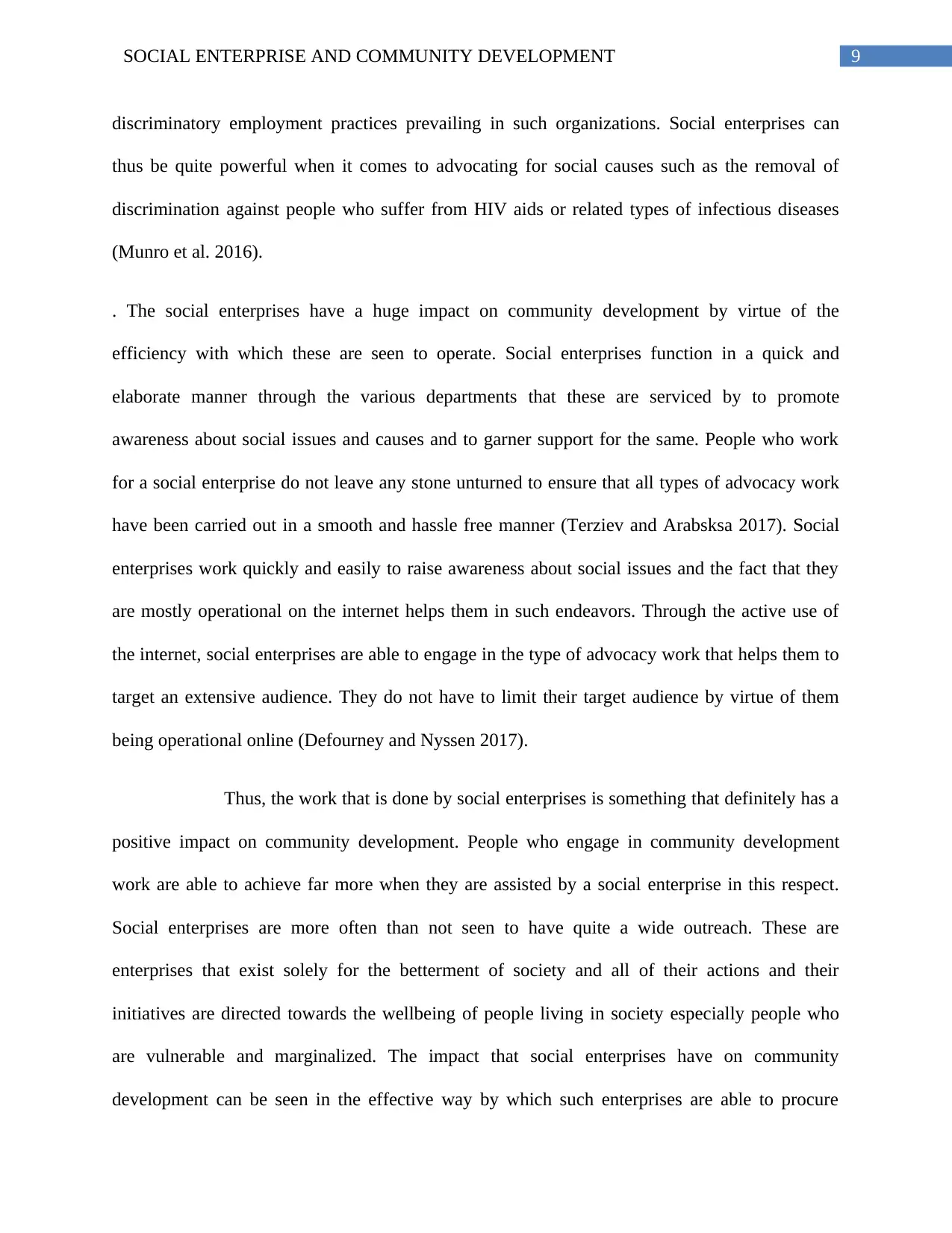
9SOCIAL ENTERPRISE AND COMMUNITY DEVELOPMENT
discriminatory employment practices prevailing in such organizations. Social enterprises can
thus be quite powerful when it comes to advocating for social causes such as the removal of
discrimination against people who suffer from HIV aids or related types of infectious diseases
(Munro et al. 2016).
. The social enterprises have a huge impact on community development by virtue of the
efficiency with which these are seen to operate. Social enterprises function in a quick and
elaborate manner through the various departments that these are serviced by to promote
awareness about social issues and causes and to garner support for the same. People who work
for a social enterprise do not leave any stone unturned to ensure that all types of advocacy work
have been carried out in a smooth and hassle free manner (Terziev and Arabsksa 2017). Social
enterprises work quickly and easily to raise awareness about social issues and the fact that they
are mostly operational on the internet helps them in such endeavors. Through the active use of
the internet, social enterprises are able to engage in the type of advocacy work that helps them to
target an extensive audience. They do not have to limit their target audience by virtue of them
being operational online (Defourney and Nyssen 2017).
Thus, the work that is done by social enterprises is something that definitely has a
positive impact on community development. People who engage in community development
work are able to achieve far more when they are assisted by a social enterprise in this respect.
Social enterprises are more often than not seen to have quite a wide outreach. These are
enterprises that exist solely for the betterment of society and all of their actions and their
initiatives are directed towards the wellbeing of people living in society especially people who
are vulnerable and marginalized. The impact that social enterprises have on community
development can be seen in the effective way by which such enterprises are able to procure
discriminatory employment practices prevailing in such organizations. Social enterprises can
thus be quite powerful when it comes to advocating for social causes such as the removal of
discrimination against people who suffer from HIV aids or related types of infectious diseases
(Munro et al. 2016).
. The social enterprises have a huge impact on community development by virtue of the
efficiency with which these are seen to operate. Social enterprises function in a quick and
elaborate manner through the various departments that these are serviced by to promote
awareness about social issues and causes and to garner support for the same. People who work
for a social enterprise do not leave any stone unturned to ensure that all types of advocacy work
have been carried out in a smooth and hassle free manner (Terziev and Arabsksa 2017). Social
enterprises work quickly and easily to raise awareness about social issues and the fact that they
are mostly operational on the internet helps them in such endeavors. Through the active use of
the internet, social enterprises are able to engage in the type of advocacy work that helps them to
target an extensive audience. They do not have to limit their target audience by virtue of them
being operational online (Defourney and Nyssen 2017).
Thus, the work that is done by social enterprises is something that definitely has a
positive impact on community development. People who engage in community development
work are able to achieve far more when they are assisted by a social enterprise in this respect.
Social enterprises are more often than not seen to have quite a wide outreach. These are
enterprises that exist solely for the betterment of society and all of their actions and their
initiatives are directed towards the wellbeing of people living in society especially people who
are vulnerable and marginalized. The impact that social enterprises have on community
development can be seen in the effective way by which such enterprises are able to procure
Paraphrase This Document
Need a fresh take? Get an instant paraphrase of this document with our AI Paraphraser
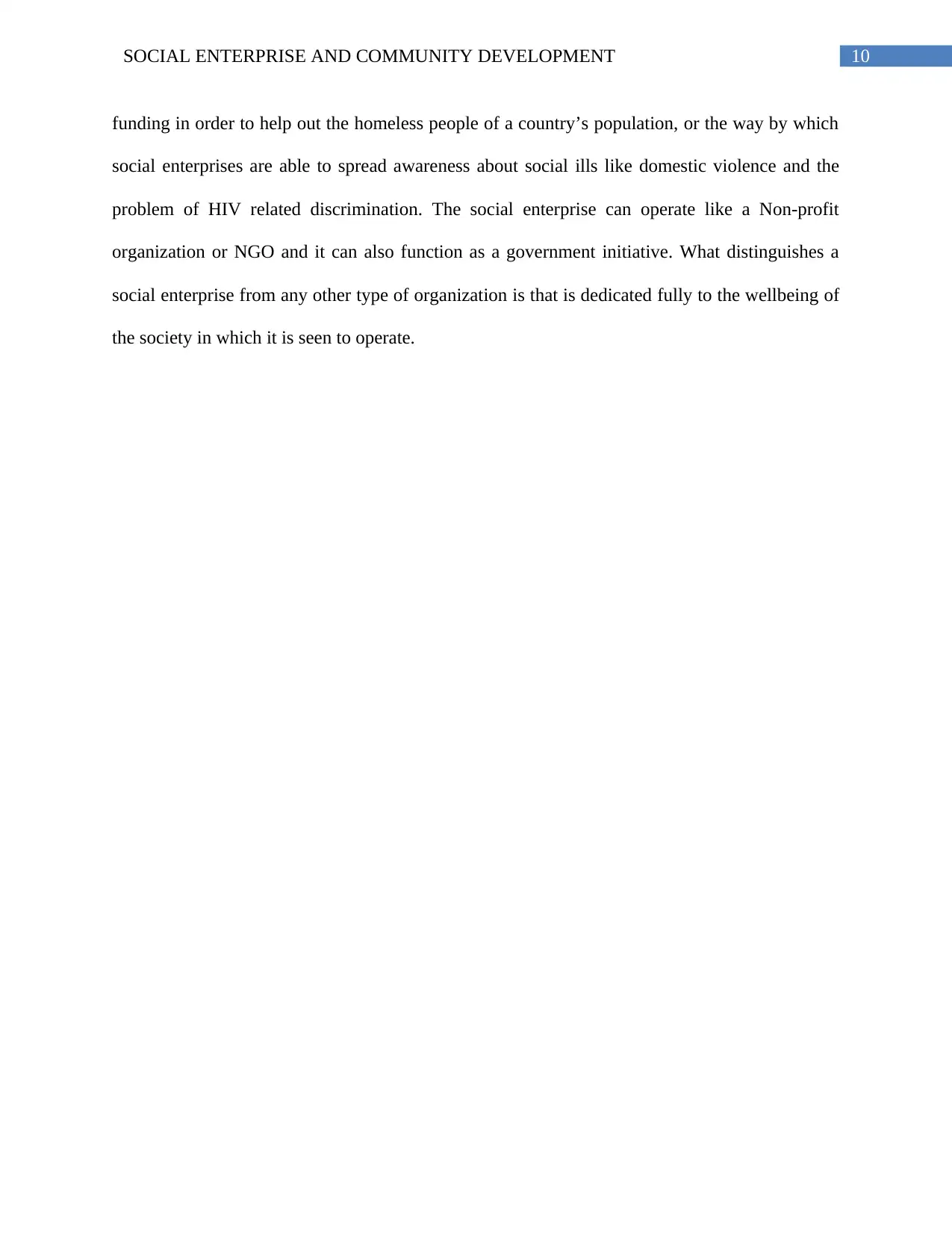
10SOCIAL ENTERPRISE AND COMMUNITY DEVELOPMENT
funding in order to help out the homeless people of a country’s population, or the way by which
social enterprises are able to spread awareness about social ills like domestic violence and the
problem of HIV related discrimination. The social enterprise can operate like a Non-profit
organization or NGO and it can also function as a government initiative. What distinguishes a
social enterprise from any other type of organization is that is dedicated fully to the wellbeing of
the society in which it is seen to operate.
funding in order to help out the homeless people of a country’s population, or the way by which
social enterprises are able to spread awareness about social ills like domestic violence and the
problem of HIV related discrimination. The social enterprise can operate like a Non-profit
organization or NGO and it can also function as a government initiative. What distinguishes a
social enterprise from any other type of organization is that is dedicated fully to the wellbeing of
the society in which it is seen to operate.
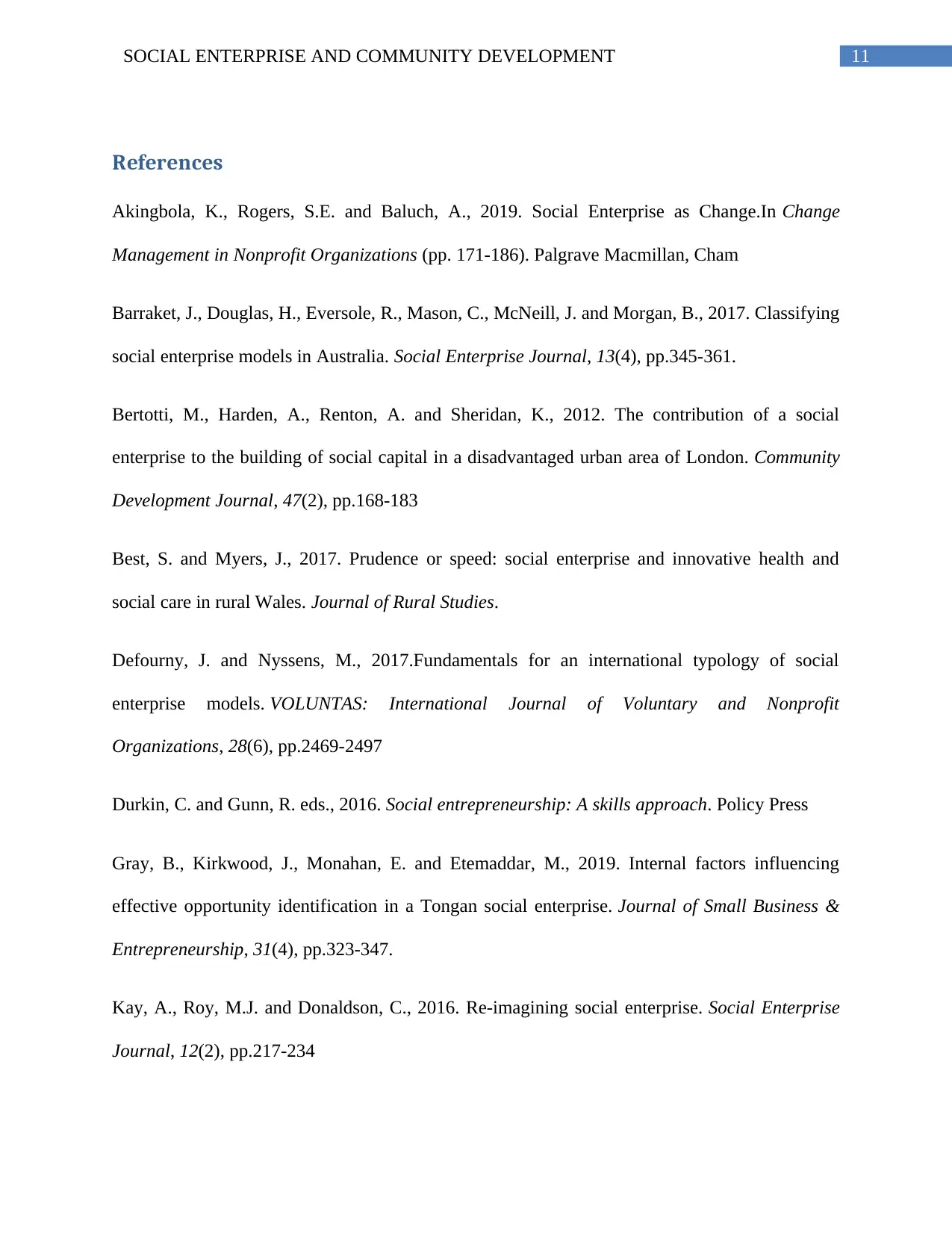
11SOCIAL ENTERPRISE AND COMMUNITY DEVELOPMENT
References
Akingbola, K., Rogers, S.E. and Baluch, A., 2019. Social Enterprise as Change.In Change
Management in Nonprofit Organizations (pp. 171-186). Palgrave Macmillan, Cham
Barraket, J., Douglas, H., Eversole, R., Mason, C., McNeill, J. and Morgan, B., 2017. Classifying
social enterprise models in Australia. Social Enterprise Journal, 13(4), pp.345-361.
Bertotti, M., Harden, A., Renton, A. and Sheridan, K., 2012. The contribution of a social
enterprise to the building of social capital in a disadvantaged urban area of London. Community
Development Journal, 47(2), pp.168-183
Best, S. and Myers, J., 2017. Prudence or speed: social enterprise and innovative health and
social care in rural Wales. Journal of Rural Studies.
Defourny, J. and Nyssens, M., 2017.Fundamentals for an international typology of social
enterprise models. VOLUNTAS: International Journal of Voluntary and Nonprofit
Organizations, 28(6), pp.2469-2497
Durkin, C. and Gunn, R. eds., 2016. Social entrepreneurship: A skills approach. Policy Press
Gray, B., Kirkwood, J., Monahan, E. and Etemaddar, M., 2019. Internal factors influencing
effective opportunity identification in a Tongan social enterprise. Journal of Small Business &
Entrepreneurship, 31(4), pp.323-347.
Kay, A., Roy, M.J. and Donaldson, C., 2016. Re-imagining social enterprise. Social Enterprise
Journal, 12(2), pp.217-234
References
Akingbola, K., Rogers, S.E. and Baluch, A., 2019. Social Enterprise as Change.In Change
Management in Nonprofit Organizations (pp. 171-186). Palgrave Macmillan, Cham
Barraket, J., Douglas, H., Eversole, R., Mason, C., McNeill, J. and Morgan, B., 2017. Classifying
social enterprise models in Australia. Social Enterprise Journal, 13(4), pp.345-361.
Bertotti, M., Harden, A., Renton, A. and Sheridan, K., 2012. The contribution of a social
enterprise to the building of social capital in a disadvantaged urban area of London. Community
Development Journal, 47(2), pp.168-183
Best, S. and Myers, J., 2017. Prudence or speed: social enterprise and innovative health and
social care in rural Wales. Journal of Rural Studies.
Defourny, J. and Nyssens, M., 2017.Fundamentals for an international typology of social
enterprise models. VOLUNTAS: International Journal of Voluntary and Nonprofit
Organizations, 28(6), pp.2469-2497
Durkin, C. and Gunn, R. eds., 2016. Social entrepreneurship: A skills approach. Policy Press
Gray, B., Kirkwood, J., Monahan, E. and Etemaddar, M., 2019. Internal factors influencing
effective opportunity identification in a Tongan social enterprise. Journal of Small Business &
Entrepreneurship, 31(4), pp.323-347.
Kay, A., Roy, M.J. and Donaldson, C., 2016. Re-imagining social enterprise. Social Enterprise
Journal, 12(2), pp.217-234
⊘ This is a preview!⊘
Do you want full access?
Subscribe today to unlock all pages.

Trusted by 1+ million students worldwide
1 out of 14
Related Documents
Your All-in-One AI-Powered Toolkit for Academic Success.
+13062052269
info@desklib.com
Available 24*7 on WhatsApp / Email
![[object Object]](/_next/static/media/star-bottom.7253800d.svg)
Unlock your academic potential
Copyright © 2020–2025 A2Z Services. All Rights Reserved. Developed and managed by ZUCOL.




